Content
Goatbeard is a common herb of the Astrov family. It got its name from the resemblance of a faded basket with a goat's beard.
Description of goatbeard
The plant has branched or single stems, widened at the base and gramineous leaves narrowed from above. It reaches a height of 30-130 cm. The root grows in length up to 50 cm, in thickness up to 4 cm in diameter.
The inflorescence is a basket with a single-row wrapper, the buds are ligulate, more often yellow, less often mauve. The flowers of the goatbeard can be seen from afar, they are similar in color and brightness to dandelions. The basket includes 5 stamens, the anthers are collected in a tube. The inferior ovary is one-seeded, has one column, the stigma is bifurcated.
Depending on the species, it blooms from May to October, ripens from June to October.
Goatbeard fruit is achene. The seeds are carried by the wind and remain viable for 3 years. They look like tufted sticks.
The plant prefers lighted places: meadows, glades, forest edges, high river banks. Loves light sandy or sandy soils. It gets along well with all meadow grasses.
In the photo of the goat plant, you can see how it looks.

The plant looks like a dandelion
Distribution area
The goatbeard herb is found throughout Europe and in temperate regions of Asia. The distribution area depends on the species. In Russia, it grows in the European part, in Western and Eastern Siberia and in the Far East.
Types of goatbeard with photo
More than 140 species of goat are known. Some of them are rare and protected. The most common in Russia are meadow, re-leafed, eastern. A brief description of the goat beetle and a photo can be seen below.
Lugovoi
Found throughout the European continent. Grows in glades, meadows, forest edges. The meadow goat is a biennial. It grows to a height of 30-90 cm. The stem is straight, pinkish-purple, with branches. Leaves are sessile, linear-lanceolate, completely marginal. The plant blooms with large single yellow baskets, which are located at the top of the stem. The wrapper consists of 8-10 leaves, equal in length to the flowers. The edge of the outer petals is pinkish. All parts of the goatbeard are considered edible. The stems and root are heat treated, young leaves are eaten raw.

Flowers of this species open and close exactly at the same time.
Doubtful
In this species, the goatbeard grows up to 0.3-1 m in height. The stems are straight, linear, sometimes slightly branched, thickened at the top (at the inflorescences), finely ribbed, pubescent at the base of the leaves or bare. Basal leaves adhere tightly to the base of the stem. Baskets are light yellow, rather large - up to 7 cm in diameter. Flowers are ligulate, bisexual. The wrapper is longer, consists of 8-12 leaves. This species of goatbeard is found in Europe and Western Asia. It prefers to settle in the steppes, in clearings, meadows, forest edges, in thickets of bushes, on the sides of roads.
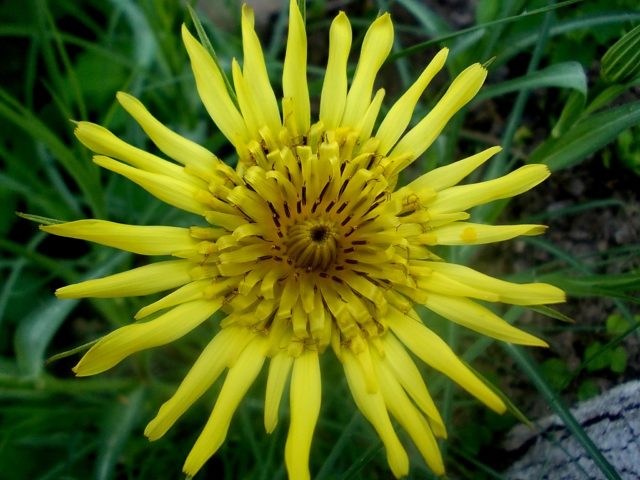
This biennial plant is used as an ornamental
Porous
This is one of the most common types.Another name for this goat is "oat root". It is grown as a root vegetable in many countries. It is a biennial plant, 0.6 m in height. It has hollow stems and lanceolate leaves. Purple flowers reach 5 cm in diameter. Edible roots grow up to 40 cm in length. They are white in color and have a slightly astringent oyster or fishy taste.
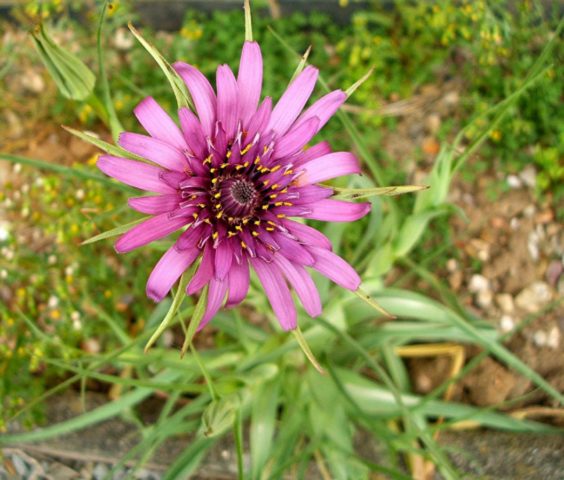
The most common type used in cooking
Donskoy
The Donskoy goat is a rare perennial plant that grows to a height of 10-50 cm. It has a taproot system. The stem can be single or several. Below the middle, they branch out. Below the leaves are sharp, narrow, about 3 cm wide, 25 cm long. Numerous flower baskets are collected in paniculate-corymbose inflorescences.
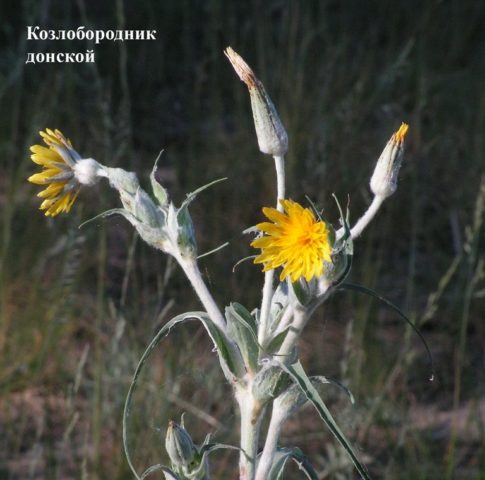
This species is endemic to the eastern regions of Ukraine
Oriental
The biennial plant reaches a height of 15-90 cm. The root of the eastern goatbeard is cylindrical, vertical. The stem is more often straight and solitary, with grooves or bare in places with felt flakes. Leaves are sessile, sharp, linear, light (gray-green). The flowers are ligulate, bright yellow, bisexual. Baskets are large, single, located at the tops of the stems. The envelope leaves are much shorter than the flowers and reach a length of 8 mm. Eastern goat is used in folk medicine, a decoction of the root is especially common as a remedy for pain, rheumatism. Grows in Eastern Europe and North Asia. It grows in dry and flooded meadows, in pine forests, in clearings, forest edges.

Eastern goatbeard is one of the main species growing in Russia
Large
Big goat is a biennial plant. It grows to a height of 30-100 cm. It has a straight, bare stem and linearly pointed leaves widened at the base. Large baskets are located on long hollow legs, club-shaped-thickened at the top. The wrapper has 8 to 12 narrow lanceolate leaves that exceed the length of the flowers. The root of the goatbeard is vertical, cylindrical, dies off after fruiting. The plant is widespread in Europe and Central Asia.

The plant is found in small quantities along steppe roads, on slopes, fallow lands
Siberian
The Siberian goat is considered a rare species, it is listed in the Red Book. This biennial plant grows up to 35-100 cm in height. It has a straight stem, branched at the top. The leaves are linear, sometimes wavy at the edges, reaching a width of 5 to 15 mm, the upper ones are shortened, elongated-ovate, sharply tapering and linearly tapering. The wrapper leaves are about 3 cm long. The flowers are purple, slightly shorter.

Siberian goatbeard is listed in the Red Book of the Sverdlovsk Region
Value and chemical composition
The roots of the plant contain many useful substances, thanks to which it is actively used by folk healers.
Among them:
- vitamins A, B1, C, E;
- potassium, phosphorus, calcium, iron, magnesium, selenium, sodium, zinc;
- choline, asparagine, inulin.
Useful properties of goatbeard
Many useful properties are attributed to the goat beetle. It is believed that it has the following actions on a person:
- improves the digestive tract, relieves diarrhea and constipation;
- increases appetite;
- normalizes metabolism;
- stimulates the body's defenses;
- is a means of preventing scurvy;
- prevents postpartum hemorrhage;
- regulates blood pressure.
Thanks to the vitamins in the composition, the goat plant improves overall well-being, relieves nervousness and anxiety, normalizes sleep, increases endurance and body defenses, has a beneficial effect on the endocrine and cardiovascular system, and improves blood composition.
Macro- and microelements in the root and grass goatbeard help to strengthen bones, teeth and hair, improve the condition of connective tissue, normalize pressure, increase the elasticity of vascular walls, prevent their fragility, prevent the formation of cholesterol plaques.
Plant application
Since ancient times, goatbeard has been used for the preparation of medicinal products. It is used in cosmetology and cooking, as well as for decorative purposes - for making bouquets.
In folk medicine
In folk medicine, milky juice, root and leaves of goat bark are used. Tinctures, infusions, decoctions are prepared from the plant.
The juice heals cuts and wounds well, helps with ulcers and purulent inflammation of the skin.

Root compresses have long been used for insect bites and allergic reactions.
Goatbeard has anti-inflammatory, diuretic, antiseptic effect. It is used as an antitussive agent, treating chronic bronchitis.
Traditional healers recommend goatbred tea for women with uterine bleeding.
For rheumatic diseases, it is applied in the form of lotions to sore spots.
It is recommended to include goatbeard in the menu of patients with diabetes mellitus to lower blood glucose levels.
In order to prevent scurvy, it is recommended to add young goatbeard leaves to food (salads, soups, etc.).
To prepare the infusion, you need to pour a glass of boiling water over 15 g of goatbeard herb. The infusion time is 4 hours. Take the product 6-8 times a day, 15 ml. This medicine has a sedative, blood-purifying, anti-allergic effect, and also normalizes salt metabolism.
The tincture is prepared from the goat root. For 1 liter of alcohol, you need to take 100 g of raw materials. Peel the root, grate, put in a glass dish and pour over with alcohol. Close the container tightly and send it to a dark, cool place for 10-14 days. Strain the prepared tincture from the root of the goatbeard and apply as needed. It has disinfectant qualities. It is used to rinse the mouth to remove unpleasant odors, as well as rubbing painful joints.
Broth goatbeard is used to treat bronchitis as an expectorant. To prepare it, you need to pour 15 g of crushed root with a glass of water, put on fire, cook for 10 minutes. Take 15 ml four times a day.
In cosmetology
Broth of goatbeard is used to rinse hair. After application, their fragility decreases, dandruff disappears, itching of the scalp disappears.
Boiled root gruel is applied to the face as a nourishing mask.
The raw crushed root removes irritation on the skin of the face and helps fight abscesses.
In cooking
In cooking, the most commonly used goat-leafed goat. The root and young leaves are eaten. Greens are processed like dandelion or nettle - added to vitamin salads, pre-scalded with boiling water to eliminate bitterness.
The root is practically not consumed in its raw form. It needs heat treatment, after which it softens and acquires a delicate pleasant taste, similar to oyster. The root of the goatbeard is straight, it is convenient to clean and grate it.
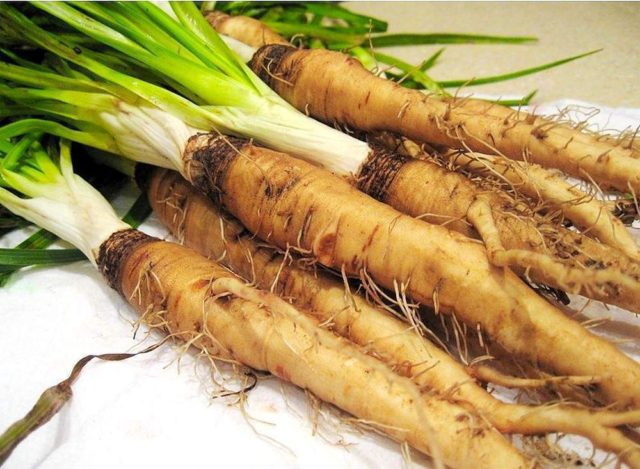
The root of the plant is eaten
Goatbeard Root Recipes
Goatbeard root is used boiled, fried, stewed, baked. It is used to prepare soups, salads, pancakes, side dishes, aromatic additives for ice cream and sweet drinks, marinades, and seasonings. It is deep-fried and fried in batter. The root of this herb goes well with many vegetables, meats, fish, cheeses, herbs, creamy sauces.
Pancakes
Ingredients:
- goatbeard root - 300 g;
- fresh cilantro - 8 g;
- chicken egg - 1 pc.;
- garlic - 1 clove;
- chili - 1 pod;
- flour - 1 tbsp. l .;
- olive oil - 2 tbsp. l .;
- butter - 45 g;
- ground black pepper - to taste;
- salt to taste.
Cooking procedure:
- Peel the goatbeard root, then grate. Put half the butter in a frying pan, heat and fry the root over medium heat until soft. Transfer to a separate bowl.
- Remove seeds from chili. Finely chop the garlic, pepper, cilantro.Combine all this, add a slightly beaten egg, fried goatroot root, flour, ground pepper, salt and mix. From this amount of dough, 6 pancakes should be made.
- Heat the olive oil and the rest of the butter in a frying pan. Fry the pancakes on both sides (4 minutes each) until golden brown.
- Serve the goat root pancakes with fried bacon or fried eggs.
Garlic soup
Ingredients:
- goatbeard root - 700 g;
- chicken broth - 2 l;
- carrots - 1 pc.;
- potatoes - 150 g;
- shallots - 4 pcs.;
- lemon - 1 pc.;
- olive oil Extra Virgin - 1 tsp;
- red lentils - 100 g;
- garlic - 1 head;
- vegetable oil - 1 tbsp. l .;
- bay leaf - 2 pcs.;
- ground pepper - to taste;
- thyme sprigs - to taste;
- salt to taste.
Cooking procedure:
- Peel the roots of the goatbeard, trying not to cut off the peel, but scrape it off with a knife. Cut into slices 1.5 cm thick. Squeeze the lemon juice into the water and put the goatbeard in it.
- Wash the head of garlic, cut off the top, capturing the cloves. Grease the slices with olive oil. Send to oven for 20 minutes. Cooking temperature - 180 degrees. When the garlic has cooled, squeeze the garlic out of the rind.
- Finely chop the shallots, dice the potatoes and carrots.
- Heat refined vegetable oil in a saucepan, fry the shallots until translucent.
- Put potatoes and carrots to the onion, fry everything together for 2 minutes. Add broth, goatberry, lentils, garlic, bay leaf, thyme.
- After boiling, cook for 20 minutes. Pieces of goatroot root should soften.
- Remove the bay leaf and thyme sprigs from the prepared soup and puree it with a blender.
- Add pepper and salt to the soup.

When serving, add a little cream or sprinkle the soup with olive oil, sprinkle with spices
Root vegetables stewed with vegetables
Ingredients:
- goatbeard root - 1 kg;
- carrots - 150 g;
- red onion - 250 g;
- tomatoes - 4 pcs.;
- garlic - 1 clove;
- celery (stem) - 150 g;
- lemon - 1 pc.;
- tomato paste - 1 tsp;
- fresh rosemary - 2 stems;
- olive oil - 150 ml;
- coarse salt - to taste;
- ground black pepper to taste.
Cooking procedure:
- Finely chop carrots, onions and celery stalk, put in a deep frying pan, add oil and cook for about 45 minutes over medium heat.
- Pour 1.5 liters of water into a suitable container, squeeze out the lemon juice. Peel the goatroot root, cut into oblong bars 6 cm long and 1 cm thick. Put the root in lemon water. This is so that it does not darken.
- Put chopped garlic and rosemary in a pan with carrots, onions and celery, simmer for about 5 minutes with constant stirring. During this time, a pronounced garlic smell should appear.
- Remove the skin from the tomatoes (first dip them in boiling water, then immediately into cold water) and knead.
- Add tomato paste and tomatoes to the pan, season with pepper, salt and continue cooking.
- After 10 minutes add goat and half a glass of water. Cover and simmer with stirring for about 40-50 minutes over medium heat.
Add water, pepper and salt if necessary. The goatbeard should become soft.
Salad with cheese and lingonberries
Ingredients:
- goatbeard - 30 g;
- cream cheese - 40 g;
- veal - 80 g;
- lettuce leaves - 25 g;
- raspberry sauce - 15 ml;
- Worcestershire sauce - 10 ml;
- cognac - 15 ml;
- pickled apples - 20 g;
- thyme - 5 g;
- olive oil for marinade and frying;
- butter;
- salt;
- pepper;
- lingonberry to taste.
Cooking procedure:
- Cut the veal fillet into 1 cm thick pieces. Marinate for 2 hours in a mixture of garlic, bay leaves, thyme, olive oil.
- Put the cream cheese on a plate.
- Season the salad leaves with raspberry sauce and place on top of the cream cheese.
- Season the veal parts with pepper and salt. Heat olive oil in a frying pan, add meat and fry for 2 minutes. Drizzle with brandy, set fire, wait for the alcohol to burn out, immediately add butter and Worcestershire sauce, stir.
- Remove the pan from the heat, put the goatberry, lingonberries, pickled apples in it, mix.
- Transfer the contents of the pan to the lettuce leaves.
Limitations and contraindications
Kozloborodnik is contraindicated for people with allergies and individual intolerance to the substances that make up it.
It is not recommended to include it in the menu and take it as a medicine for children under three years old, for pregnant and lactating women.
It is worth giving up the goatbeard for people with low blood pressure, increased blood clotting, with a tendency to diarrhea, with high acidity of gastric juice.
Collection and procurement of raw materials
The collection of the ground part of the goatbeard occurs during the flowering of the plant, while the flowers are pinched off. The stems are dense, so they are not plucked, but cut off with scissors or a sickle. Milky sap is released on the cut, which can cause irritation, therefore, it is recommended to collect goatbeard grass with gloves. Greens are dried, crushed and placed in a glass container. Shelf life is 2 years.
The roots are dug out after the first frost. This must be done carefully, without damaging the processes. Whole, ripe roots can be stored well until the next spring or summer in a cool, dry place.
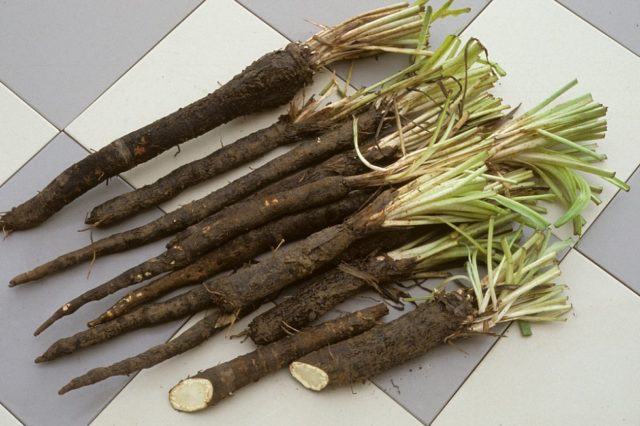
Unripe and broken off roots will not lie for a long time
Conclusion
Goatbeard is a herb that has beneficial properties and good taste. Due to this, its leaves and roots are widely used to maintain health and to prepare various delicious and even delicious dishes.
https://youtu.be/hi3Ed2Rg1rQ








